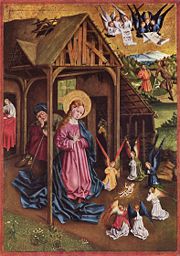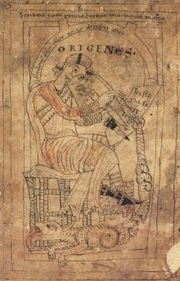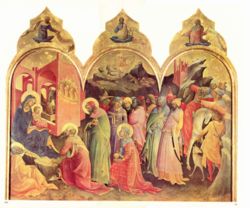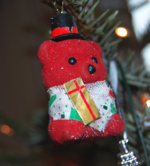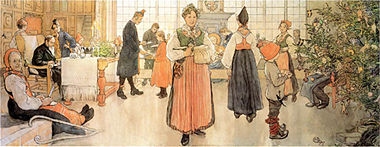Christmas
2008/9 Schools Wikipedia Selection. Related subjects: Religious movements, traditions and organizations
| Christmas | |
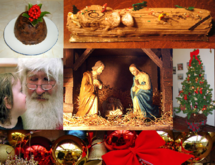 |
|
| Also called | Christ's Mass Nativity Incarnation Yule Tide Noel Winter Pascha |
|---|---|
| Observed by | Christians around the world as well as many non-Christians |
| Type | Christian, cultural |
| Significance | Nativity of Jesus |
| Date | 25 December in Western Christianity and some Eastern Orthodox Churches 24 December in some countries 6 January in the Armenian Apostolic Church 7 January in most Eastern Orthodox Churches. |
| Observances | Religious services, gift giving, family meetings, decorating trees |
| Related to | Annunciation, Incarnation, Advent, Epiphany, Baptism of the Lord, Winter solstice |
Christmas (IPA: /krɪsməs/) is an annual holiday that celebrates the birth of Jesus. It refers to both the day commemorating the birth, and also the Christmastide season which that day inaugurates, concluding with the Feast of the Epiphany. The date of the celebration is traditional, and is not considered to be Jesus's actual date of birth. Christmas festivities often combine the observation of the Nativity with various cultural customs, many of which have been influenced by earlier winter festivals. Although nominally a Christian holiday, it is also observed as a cultural holiday by many non-Christians around the world. On the other hand, there are some Christian denominations, like Jehovah's Witnesses, certain Seventh Day Adventist churches, and the Living Church of God, whose members do not, as a rule, celebrate Christmas. It was not until the reign of Queen Victoria that many of the Christian customs occur. In most places around the world, Christmas Day is celebrated on 25 December. Christmas Eve begins at the evening of the preceding date, 24 December. In Germany and some other countries, the main Christmas celebrations commence on Christmas' Eve. The day following Christmas Day, 26 December, is called Boxing Day in the United Kingdom and many countries of the Commonwealth, and called St. Stephen's Day or the Feast of Saint Stephen in Catholic countries. The Armenian Apostolic Church observes Christmas on 6 January. Eastern Orthodox Churches that still use the Julian Calendar celebrate Christmas on the Julian version of 25 December, which is 7 January on the more widely used Gregorian calendar, because the two calendars are now 13 days apart.
The prominence of Christmas Day increased gradually after Charlemagne was crowned on Christmas Day in 800. Around the 12th century, the remnants of the former Saturnalian traditions of the Romans were transferred to the Twelve Days of Christmas ( 25 December – 5 January). Christmas during the Middle Ages was a public festival, incorporating ivy, holly, and other evergreens, as well as gift-giving.
Modern traditions have come to include the display of Nativity scenes, holly and Christmas trees, the exchange of gifts and cards, and the arrival of Father Christmas or Santa Claus on Christmas Eve or Christmas morning. Popular Christmas themes include the promotion of goodwill and peace.
Etymology
The word Christmas originated as a contraction of " Christ's mass". It is derived from the Middle English Christemasse and Old English Cristes mæsse, a phrase first recorded in 1038, compounded from Old English derivatives of the Greek christos and the Latin missa. In early Greek versions of the New Testament, the letter Χ (chi), is the first letter of Christ. Since the mid-16th century Χ, or the similar Roman letter X, has been used as an abbreviation for Christ. Hence, Xmas is often used as an abbreviation for Christmas.
After the conversion of Anglo-Saxon Britain in the very early 7th century, Christmas was referred to as geol, the name of the pre-Christian winter festival from which the current English word ' Yule' is derived.
The Nativity
The Nativity of Jesus refers to the Christian belief that the Messiah was born to the Virgin Mary. The story of Christmas is based on the biblical accounts given in the Gospel of Matthew, namely Matthew 1:18- Matthew 2:12 and the Gospel of Luke, specifically Luke 1:26- Luke 2:40. According to these accounts, Jesus was born to Mary, assisted by her husband Joseph, in the city of Bethlehem. According to popular tradition, the birth took place in a "stable", surrounded by farm animals, though neither the “stable” nor the animals are mentioned in the Biblical accounts. However, a " manger" is mentioned in Luke 2:7 where it states "She wrapped him in cloths and placed him in a manger, because there was no room for them in the inn." Early iconographic representations of the nativity confirm that the stable and manger were located within a cave (which still exists under the Church of the Nativity in Bethlehem). Shepherds from the fields surrounding Bethlehem were told of the birth by an angel, and were the first to see the child. Christians believe that the birth of Jesus fulfilled many prophecies made hundreds of years before his birth. Two major studies are J Gresham Machen "The Virgin Birth of Christ" and Peter Sammons "The Birth of Christ" (latter published 2006).
Remembering is a central way that Christians celebrate Christmas. There is a very long tradition of the Nativity of Jesus in art. The Eastern Orthodox Church practices the Nativity Fast in anticipation of the birth of Jesus, while much of the Western Church celebrates Advent. In some Christian denominations, children perform plays re-telling the events of the Nativity, or sing carols that reference the event. Some Christians also display a small re-creation of the Nativity, known as a Nativity scene, in their homes, using figurines to portray the key characters of the event. Live Nativity scenes, and tableaux vivants are also performed, using actors and live animals to portray the event with more realism.
Nativity scenes traditionally include the Three Wise Men, Balthazar, Melchior, and Caspar, although their names and number are not referred to in the Biblical narrative, who are said to have followed a star, known as the Star of Bethlehem, found Jesus, and presented gifts of gold, frankincense, and myrrh.
In the U.S., Christmas decorations at public buildings once commonly included Nativity scenes. This practice has led to many lawsuits, as groups such as the American Civil Liberties Union believe it amounts to the government endorsing a religion, which is prohibited by the United States Constitution. In 1984, the U.S. Supreme Court ruled in Lynch vs. Donnelly that a Christmas display (which included a Nativity scene) owned and displayed by the city of Pawtucket, Rhode Island did not violate the First Amendment.
History
Pre-Christian origins
A winter festival was traditionally the most popular festival of the year in many cultures. Reasons included less agricultural work needing to be done during the winter, as well as people expecting longer days and shorter nights after the winter solstice in the Northern Hemisphere. In part, the Christmas celebration was created by the early Church in order to entice pagan Romans to convert to Christianity without losing their own winter celebrations. Certain prominent gods and goddesses of other religions in the region had their birthdays celebrated on 25 December, including Ishtar, Babylonian goddess of fertility, love, and war, Sol Invictus and Mithras. Modern Christmas with pagan customs include: gift-giving and merrymaking from Roman Saturnalia; greenery, lights, and charity from the Roman New Year; and Yule logs and various foods from Teutonic feasts. Such traditions are considered to have been syncretised from winter festivals including the following:
Natalis Solis Invicti
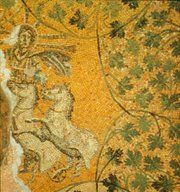
The Romans held a festival on 25 December called Dies Natalis Solis Invicti, "the birthday of the undefeated sun." The use of the title Sol Invictus allowed several solar deities to be worshipped collectively, including Elah-Gabal, a Syrian sun god; Sol, the god of Emperor Aurelian (AD 270–274); and Mithras, a soldiers' god of Persian origin. Emperor Elagabalus (218–222) introduced the festival, and it reached the height of its popularity under Aurelian, who promoted it as an empire-wide holiday.
December 25 was considered the day upon which the winter solstice, which the Romans called bruma, fell. (When Julius Caesar introduced the Julian Calendar in 45 BC, 25 December was approximately the date of the solstice. In modern times, the solstice falls on December 21 or 22.) It is the day the Sun proves itself to be "unconquered" and begins its movement toward the north on the horizon. The Sol Invictus festival has a "strong claim on the responsibility" for the date of Christmas, according to the Catholic Encyclopedia. Several early Christian writers connected the rebirth of the sun to the birth of Jesus "O, how wonderfully acted Providence that on that day on which that Sun was born . . . Christ should be born", Cyprian wrote.
Yule
Pagan Scandinavia celebrated a winter festival called Yule, held in the late December to early January period. Yule logs were lit to honour Thor, the god of thunder, with the belief that each spark from the fire represented a new pig or calf that would be born during the coming year. Feasting would continue until the log burned out, which could take as many as twelve days. In pagan Germania (not to be confused with Germany), the equivalent holiday was the mid-winter night which was followed by 12 "wild nights", filled with eating, drinking and partying. As Northern Europe was the last part to Christianize, its pagan celebrations had a major influence on Christmas. Scandinavians still call Christmas Jul. In English, the Germanic word Yule is synonymous with Christmas, a usage first recorded in 900.
Christian origins
It is unknown exactly when or why 25 December became associated with Christ's birth. The New Testament does not give a specific date. Sextus Julius Africanus popularized the idea that Christ was born on December 25 in his Chronographiai, a reference book for Christians written in AD 221. This date is nine months after the traditional date of the Incarnation ( 25 March), now celebrated as the Feast of the Annunciation. 25 March was considered to be the date of the vernal equinox and early Christians believed this was also the date Christ was crucified. The Christian idea that Christ was conceived on the same date that he died on the cross is consistent with a Jewish belief that a prophet lived an integral number of years.
The celebration of Christmas as a feast did not arise for some time after Chronographai was published. Tertullian does not mention it as a major feast day in the Church of Roman Africa. In 245, the theologian Origen denounced the idea of celebrating Christ's birthday "as if he were a king pharaoh". He contended that only sinners, not saints, celebrated their birthdays.
The earliest reference to the celebration of the nativity on December 25 is found in the Chronography of 354, an illuminated manuscript compiled in Rome in 354. In the East, early Christians celebrated the birth of Christ as part of Epiphany (January 6), although this festival focused on the baptism of Jesus.
Christmas was promoted in the Christian East as part of the revival of Catholicism following the death of the pro- Arian Emperor Valens at the Battle of Adrianople in 378. The feast was introduced to Constantinople in 379, and to Antioch in about 380. The feast disappeared after Gregory of Nazianzus resigned as bishop in 381, although it was reintroduced by John Chrysostom in about 400.
The Twelve Days of Christmas are the twelve days from the day after Christmas Day, December 26, which is St. Stephen's Day, to the Feast of Epiphany on 6 January that encompass the major feasts surrounding the birth of Christ. In the Latin Rite, one week after Christmas Day, 1 January, has traditionally been the celebration the Feast of the Naming and Circumcision of Christ, but since Vatican II, this feast has been celebrated as the Solemnity of Mary, Mother of God.
In some traditions the 12 days of Christmas start on Christmas Day (25 December) and the 12th day is therefore 5 January.
Middle Ages
In the Early Middle Ages, Christmas Day was overshadowed by Epiphany, which in the west focused on the visit of the magi. But the Medieval calendar was dominated by Christmas-related holidays. The forty days before Christmas became the "forty days of St. Martin" (which began on 11 November, the feast of St. Martin of Tours), now known as Advent. In Italy, former Saturnalian traditions were attached to Advent. Around the 12th century, these traditions transferred again to the Twelve Days of Christmas ( 26 December – 6 January); a time that appears in the liturgical calendars as Christmastide or Twelve Holy Days. The prominence of Christmas Day increased gradually after Charlemagne was crowned Emperor on Christmas Day in 800. King Edmund the Martyr was anointed on Christmas in 855 and King William I of England was crowned on Christmas Day 1066. By the High Middle Ages, the holiday had become so prominent that chroniclers routinely noted where various magnates celebrated Christmas. King Richard II of England hosted a Christmas feast in 1377 at which twenty-eight oxen and three hundred sheep were eaten. The Yule boar was a common feature of medieval Christmas feasts. Caroling also became popular, and was originally a group of dancers who sang. The group was composed of a lead singer and a ring of dancers that provided the chorus. Various writers of the time condemned caroling as lewd, indicating that the unruly traditions of Saturnalia and Yule may have continued in this form. "Misrule" — drunkenness, promiscuity, gambling — was also an important aspect of the festival. In England, gifts were exchanged on New Year's Day, and there was special Christmas ale. Christmas during the Middle Ages was a public festival that incorporating ivy, holly, and other evergreens. Christmas gift-giving during the Middle Ages was usually between people with legal relationships, such as tenant and landlord.
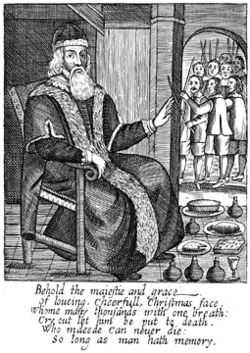
From the Reformation into the 1800s
During the Reformation, some Protestants condemned Christmas celebration as "trappings of popery" and the "rags of the Beast." The Roman Catholic Church responded by promoting the festival in a more religiously oriented form. Following the Parliamentarian victory over King Charles I during the English Civil War, England's Puritan rulers banned Christmas, in 1647. Pro-Christmas rioting broke out in several cities, and for weeks Canterbury was controlled by the rioters, who decorated doorways with holly and shouted royalist slogans. The Restoration of Charles II in 1660 ended the ban, but many clergymen still disapproved of Christmas celebration.
In Colonial America, the Puritans of New England disapproved of Christmas. Celebration was outlawed in Boston from 1659 to 1681. At the same time, Christian residents of Virginia and New York observed the holiday freely. Christmas fell out of favour in the United States after the American Revolution, when it was considered an English custom. George Washington attacked Hessian mercenaries on Christmas during the Battle of Trenton in 1777. (Christmas being much more popular in Germany than in America at this time.) By the 1820s, sectarian tension had eased and British writers, including William Winstanly began to worry that Christmas was dying out. These writers imagined Tudor Christmas as a time of heartfelt celebration, and efforts were made to revive the holiday. Charles Dickens's book A Christmas Carol, published in 1843, played a major role in reinventing Christmas as a holiday emphasizing family, goodwill, and compassion as opposed to communal celebration and hedonistic excess. In America, interest in Christmas was revived in the 1820s by several short stories by Washington Irving which appear in his The Sketch Book of Geoffrey Crayon and "Old Christmas", and by Clement Clarke Moore's 1822 poem A Visit From St. Nicholas (popularly known by its first line: Twas the Night Before Christmas). Irving's stories depicted harmonious warm-hearted holiday traditions he claimed to have observed in England. Although some argue that Irving invented the traditions he describes, they were widely imitated by his American readers. The poem A Visit from Saint Nicholas popularized the tradition of exchanging gifts and seasonal Christmas shopping began to assume economic importance. In her 1850 book "The First Christmas in New England", Harriet Beecher Stowe includes a character who complains that the true meaning of Christmas was lost in a shopping spree. Christmas was declared a United States Federal holiday in 1870, signed into law by President Ulysses S. Grant.
Santa Claus and other bringers of gifts
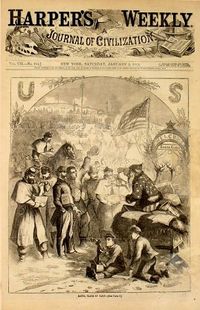
Originating from Western culture, where the holiday is characterized by the exchange of gifts among friends and family members, some of the gifts are attributed to a character called Santa Claus (also known as Father Christmas, Saint Nicholas or St. Nikolaus, Sinterklaas, Kris Kringle, Père Noël, Joulupukki, Babbo Natale, Weihnachtsmann, Saint Basil and Father Frost).
The popular image of Santa Claus was created by the German-American cartoonist Thomas Nast (1840–1902), who drew a new image annually, beginning in 1863. By the 1880s, Nast's Santa had evolved into the form we now recognize. The image was standardized by advertisers in the 1920s.
Father Christmas, who predates the Santa Claus character, was first recorded in the 15th century, but was associated with holiday merrymaking and drunkenness. In Victorian Britain, his image was remade to match that of Santa. The French Père Noël evolved along similar lines, eventually adopting the Santa image. In Italy, Babbo Natale acts as Santa Claus, while La Befana is the bringer of gifts and arrives on the eve of the Epiphany. It is said that La Befana set out to bring the baby Jesus gifts, but got lost along the way. Now, she brings gifts to all children. In some cultures Santa Claus is accompanied by Knecht Ruprecht, or Black Peter. In other versions, elves make the toys. His wife is referred to as Mrs. Claus.
The current tradition in several Latin American countries (such as Venezuela) holds that while Santa makes the toys, he then gives them to the Baby Jesus, who is the one who actually delivers them to the children's homes. This story is meant to be a reconciliation between traditional religious beliefs and modern day globalization, most notably the iconography of Santa Claus imported from the United States.
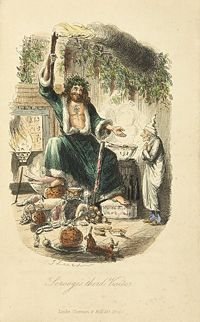
In Alto Adige/Südtirol (Italy), Austria, Czech Republic, Southern Germany, Hungary, Liechtenstein, Slovakia and Switzerland, the Christkind ( Ježíšek in Czech, Jézuska in Hungarian and Ježiško in Slovak) brings the presents. The German St. Nikolaus is not identical with the Weihnachtsman (who is the German version of Santa Claus). St. Nikolaus wears a bishop's dress and still brings small gifts (usually candies, nuts and fruits) on 6 December and is accompanied by Knecht Ruprecht. Although many parents around the world routinely teach their children about Santa Claus and other gift bringers, some have come to reject this practice, considering it deceptive.
Christmas tree and other decorations
The Christmas tree is often explained as a Christianization of pagan tradition and ritual surrounding the Winter Solstice, which included the use of evergreen boughs, and an adaptation of pagan tree worship. The English language phrase "Christmas tree" is first recorded in 1835 and represents an importation from the German language. The modern Christmas tree tradition is believed to have begun in Germany in the 18th century though many argue that Martin Luther began the tradition in the 16th century. From Germany the custom was introduced to England, first via Queen Charlotte, wife of George III, and then more successfully by Prince Albert during the reign of Queen Victoria. Around the same time, German immigrants introduced the custom into the United States. Christmas trees may be decorated with lights and ornaments.
Since the 19th century, the poinsettia has been associated with Christmas. Other popular holiday plants include holly, mistletoe, red amaryllis, and Christmas cactus. Along with a Christmas tree, the interior of a home may be decorated with these plants, along with garlands and evergreen foliage.
In Australia, North and South America, and to a lesser extent Europe, it is traditional to decorate the outside of houses with lights and sometimes with illuminated sleighs, snowmen, and other Christmas figures. Municipalities often sponsor decorations as well. Christmas banners may be hung from street lights and Christmas trees placed in the town square.
In the Western world, rolls of brightly-colored paper with secular or religious Christmas motifs are manufactured for the purpose of wrapping gifts. The display of Christmas villages has also become a tradition in many homes during this season. Other traditional decorations include bells, candles, candy canes, stockings, wreaths, and angels.
Christmas decorations are traditionally taken down on Twelfth Night, the evening of 5 January.
Christmas stamps

A number of nations have issued commemorative stamps at Christmastime. Postal customers will often use these stamps for the mailing of Christmas cards, and they are popular with philatelists. These stamps are regular postage stamps, unlike Christmas seals, and are valid for postage year-round. They usually go on sale some time between early October and early December, and are printed in considerable quantities.
In 1898 a Canadian stamp was issued to mark the inauguration of the Imperial Penny Postage rate. The stamp features a map of the globe and bears an inscription "XMAS 1898" at the bottom. In 1937, Austria issued two "Christmas greeting stamps" featuring a rose and the signs of the zodiac. In 1939, Brazil issued four semi-postal stamps with designs featuring the three kings and a star of Bethlehem, an angel and child, the Southern Cross and a child, and a mother and child.
The US Postal Service regularly issues both a religious-themed and a secular-themed stamp each year.
Economics of Christmas
Christmas is typically the largest annual economic stimulus for many nations. Sales increase dramatically in almost all retail areas and shops introduce new products as people purchase gifts, decorations, and supplies. In the U.S., the "Christmas shopping season" generally begins on Black Friday, the day after Thanksgiving, though many American stores begin selling Christmas items as early as October.
In most areas, Christmas Day is the least active day of the year for business and commerce; almost all retail, commercial and institutional businesses are closed, and almost all industries cease activity (more than any other day of the year). In England and Wales, the Christmas Day (Trading) Act 2004 prevents all large shops from trading on Christmas Day. Scotland is currently planning similar legislation. Film studios release many high-budget movies in the holiday season, including Christmas films, fantasy movies or high-tone dramas with high production values.
An economists analysis calculates that Christmas is a deadweight loss under orthodox microeconomic theory, due to the surge in gift-giving. This loss is calculated as the difference between what the gift giver spent on the item and what the gift receiver would have paid for the item. It is estimated that in 2001 Christmas resulted in a $4 billion deadweight loss in the U.S. alone. Because of complicating factors, this analysis is sometimes used to discuss possible flaws in current microeconomic theory. Other deadweight losses include the effects of Christmas on the environment and the fact that material gifts are often perceived as white elephants, imposing cost for upkeep and storage and contributing to clutter.
Alternative names
There are several alternative terms for Christmas. Crimbo is a slang term which first appeared in print in 1928; the variant form Crimble was first used by John Lennon in a 1963 Beatles' Fan Club Christmas single. Xmas is a long established abbreviation, though it is involved in the secularization of Christmas debate. Yule is used in Northern Europe. In the USA, the term(s) " holiday" or "season" may be used, as addressed at Christmas controversy.
U.S. Christmas controversy
Throughout the 20th century, the United States experienced what became known as the Christmas controversies, despite it being declared a federal holiday on June 26, 1870 by then-U.S. President Ulysses S. Grant. The importance of the economic impact of the secular Christmas holiday was reinforced in the 1930s when President Franklin D. Roosevelt proposed moving the Thanksgiving holiday date to extend the Christmas shopping season and boost the economy during the Great Depression. Religious leaders protested this move, with a New York Times roundup of Christmas sermons showing the most common theme as the dangers of an increasingly commercial Christmas.
Some considered the U.S. government's recognition of Christmas as a federal holiday to be a violation of the separation of church and state. This was brought to trial several times, recently including in Lynch v. Donnelly (1984) and Ganulin v. United States (1999).
On 6 December 1999, the verdict for Ganulin v. United States (1999) declared that "the establishment of Christmas Day as a legal public holiday does not violate the Establishment Clause because it has a valid secular purpose." This decision was upheld by the Sixth Circuit Court of Appeals on 19 December 2000. At the same time, many devout Christians objected to what they saw as the vulgarization and co-optation of one of their sacred observances by secular commercial society and calls to a return to "the true meaning of Christmas" are common.
Debates about Christmas in America continued into the 21st century. In 2005, some Christians, along with American political commentators such as Bill O'Reilly, protested what they perceived to be the secularization of Christmas. They felt that the holiday was threatened by a general secular trend, or by persons and organizations with an anti-Christian agenda. The perceived trend was also blamed on political correctness.
Books
- Christmas in America: A History, by Penne L. Restad (New York: Oxford University Press, 1995). ISBN 0-19-509300-3
- The Battle for Christmas, by Stephen Nissenbaum (1996; New York: Vintage Books, 1997). ISBN 0-679-74038-4
- The Origins of Christmas, by Joseph F. Kelly (August 2004: Liturgical Press) ISBN 978-0814629840
- Christmas Customs and Traditions, by Clement A. Miles (1976: Dover Publications) ISBN 978-0486233543
- The World Encyclopedia of Christmas, by Gerry Bowler (October 2004: McClelland & Stewart) ISBN 978-0771015359
- Santa Claus: A Biography, by Gerry Bowler (November 2007: McClelland & Stewart) ISBN 978-0771016684
- There Really Is a Santa Claus: The History of St. Nicholas & Christmas Holiday Traditions, by William J. Federer (December 2002: Amerisearch) ISBN 978-0965355742
- St. Nicholas: A Closer Look at Christmas, by Jim Rosenthal (July 2006: Nelson Reference) ISBN 1418504076
- Just say Noel: A History of Christmas from the Nativity to the Nineties, by David Comfort (November 1995: Fireside) ISBN 978-0684800578
- 4000 Years of Christmas: A Gift from the Ages, by Earl W. Count (November 1997: Ulysses Press) ISBN 978-1569750872
- The Birth of Christ", by Peter Sammons (May 2006: Glory to Glory Publications) (UK) ISBN 0-9551790-1-7
